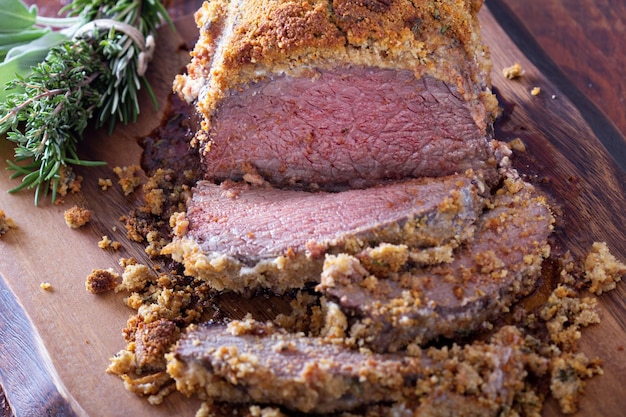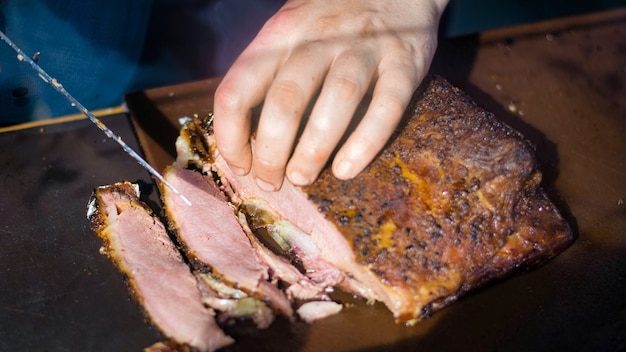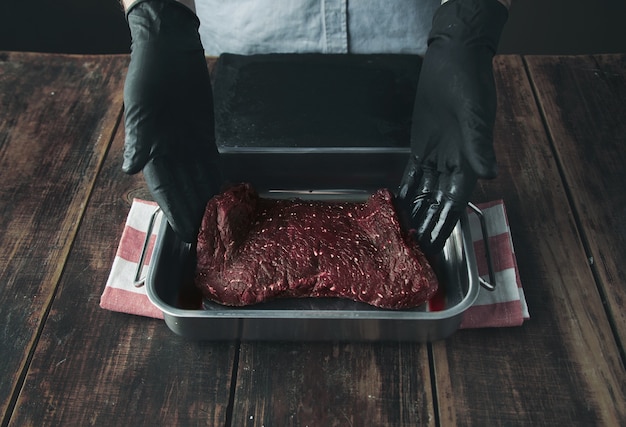(Part 1) - Choosing Your Ribeye: The Foundation of a Great Steak

1. Marbling
That lovely, intricate web of white fat throughout the meat – the marbling – is what gives the ribeye its incredible flavour and incredible tenderness. Look for a good amount of marbling, distributed evenly throughout the steak. Imagine it like beautiful, delicate brushstrokes across a canvas, and you'll be on the right track. The more marbling, the more flavour and tenderness you'll have in your final steak.2. Thickness
A ribeye needs to have a decent thickness to it. Aim for a steak that's around 1.5 to 2 inches thick. This allows for a beautiful sear on the outside and a perfectly cooked, tender centre. Think of it like a juicy burger, but bigger and better, a steak that can truly stand on its own.3. Colour
A good ribeye should have a vibrant, dark red colour. This is a sign of freshness and quality, indicating that the meat is healthy and hasn't been sitting around for too long. You might see some lighter spots, but that's okay. Just make sure the overall tone is a deep, rich red, the colour of a beautiful ruby.4. Feel
Finally, give your chosen ribeye a little squeeze. The meat should feel firm and springy, but not hard. It should give a little under your touch, like a well-made cushion. It's a delicate balance, but you'll get the hang of it with a little practice.(Part 2) - Preparing the Steak: Getting Ready for the Oven

1. Temperature
Take your ribeye out of the fridge and let it sit on the counter for at least 30 minutes. This is a crucial step – allowing the meat to come to room temperature ensures an even cook. No one wants a cold steak, right? Think of it like warming up your muscles before a workout – it makes the cooking process smoother and more efficient.2. Seasoning
Now, this is where you get to let your culinary creativity shine. Personally, I'm a simple man when it comes to seasoning – salt and pepper, and that's about it. I find the natural flavour of the ribeye speaks for itself, and a simple seasoning allows that flavour to shine. But feel free to experiment with other seasonings like garlic powder, paprika, or even a little bit of dried rosemary. Just remember, less is more, especially when it comes to salt. You don't want to overpower the natural flavours of the steak.3. The Rub
Once you've decided on your seasoning, give your ribeye a good rub. Don't be shy – work those spices into the meat, get them in all those little crevices. Imagine it like a massage for your steak, a gentle, loving touch that awakens the flavours.4. The Fat
Now, here's a little secret that makes all the difference: trim any excess fat from the ribeye, but don't remove it all. That fat is going to render down and add even more flavour to your steak. Think of it like a built-in flavour bomb, adding depth and richness to every bite.(Part 3) - The Oven-Baking Technique: The Key to Success

1. Preheat the Oven
First things first, get your oven nice and hot. We're talking 450°F (232°C), a good, high heat that's going to create a fantastic sear. Imagine a roaring fire, that's what we're aiming for, the kind of heat that makes the steak sing.2. The Pan
You'll need a large, heavy-bottomed skillet for this. Cast iron is ideal, but any sturdy pan that can handle the heat will do. Think about it – you're going to be searing the steak in this pan, so you want something that can withstand the intensity.3. The Sear
Place your skillet on the stovetop over high heat. Add a tablespoon of oil, let it get nice and hot, then carefully place your ribeye in the pan. This is where the real magic happens. You want to sear the steak for about 2-3 minutes per side, getting a beautiful, crispy crust that's a symphony of flavour and texture. Don't be afraid to give the pan a good swirl to make sure the oil gets evenly distributed and the steak cooks evenly.4. Into the Oven
Once you've got a nice crust on all sides, transfer the pan, with the steak still in it, to your preheated oven. This is where the oven does its thing, creating that perfect, juicy interior. The high heat gives the steak a beautiful sear, while the oven gently cooks it to perfection.5. Cook Time
Now, here's where it gets tricky. Cook time depends on how you like your steak. For a rare steak, aim for 8-10 minutes. Medium-rare, 10-12 minutes. Medium, 12-14 minutes. And well-done, 14-16 minutes. Just remember, these are just guidelines. The best way to tell if your steak is cooked to your liking is to use a meat thermometer. It's the most accurate way to ensure you get your steak cooked exactly how you like it.(Part 4) - Resting: Letting the Steak Relax
You've just created a culinary masterpiece, a work of art, and it needs a little time to unwind, to recover from its oven adventure.1. The Importance of Resting
Once the steak is cooked to your liking, take it out of the oven and transfer it to a cutting board. Let it rest for 10-15 minutes, covered with foil. This allows the juices to redistribute throughout the steak, resulting in a more tender and flavorful cut. The juices will travel throughout the meat, making every bite incredibly juicy and flavorful.2. The Juices
While the steak is resting, you'll notice a little pool of delicious juice forming on the cutting board. Don't throw that away! That's pure steak flavour, a flavour bomb waiting to be unleashed. You can use it to make a delicious pan sauce later on. It's pure steak magic, a concentrated essence of flavour waiting to be added back into the dish.(Part 5) - Slicing and Serving: The Grand Finale
We're almost there, folks! The steak is rested, the juices are flowing, and it's time to take this culinary masterpiece to the next level.1. The Slicing
Slice your ribeye against the grain. This means cutting across the muscle fibers, creating tender, juicy bites. Think of it like cutting a loaf of bread – you want to go across the slices, not down them. This simple technique makes all the difference in the texture of your steak.2. The Plate
Now, you've got a few options here. You can simply serve the steak as is, or you can add a touch of elegance. Add some roasted vegetables, mashed potatoes, a creamy sauce. Whatever you choose, make it a plate worthy of this incredible steak.3. Enjoy!
And finally, the most important part: enjoy! Savour every bite, every morsel of that juicy, flavour-packed steak. You've earned it!(Part 6) - Pan Sauce: A Touch of Extra Magic
Okay, so we've got the perfect steak, but let's take it up a notch with a delicious pan sauce. This is where the magic of the juices really shines.1. The Deglazing
While the steak is resting, pour off any excess oil from the pan. Add a tablespoon of butter, let it melt, then add a tablespoon of flour. Whisk them together until it forms a smooth paste. This is called a roux, and it's going to thicken our sauce.2. The Flavour
Now, it's time to add some flavour. Pour in a cup of your favourite broth, whether it's beef, chicken, or even red wine. Bring it to a simmer and whisk constantly until the sauce thickens. The juices from the steak will give it an amazing flavour, but feel free to add some fresh herbs, garlic, or even a splash of lemon juice for an extra kick.3. The Finishing Touch
Once your sauce is thick and delicious, taste it and adjust the seasoning. Add a little more salt, pepper, or any other spices you like. You can even add a pat of butter to add a touch of richness.4. Pour it On
Spoon the sauce over your ribeye steak and serve. The sauce will add a delicious depth of flavour and make your steak even more special.(Part 7) - Tips and Tricks: Mastering the Art of Oven-Baked Ribeye
Here's a little secret, sometimes, the best recipes come with a few handy tricks that elevate the game.1. Don't Overcrowd the Pan
If you're cooking multiple steaks, don't crowd the pan. Give them enough space to sear properly. You want each steak to have its own little space to breathe, to ensure an even cook.2. Don't Overcook
Everyone has their own preference for doneness, but remember, a good ribeye should be juicy and tender. Overcooking will make it tough and dry. Use a meat thermometer to make sure you're cooking it to your liking. It's the best way to guarantee that you get that perfect, juicy steak you're craving.3. Rest, Rest, Rest
I can't stress this enough. Resting is crucial for a delicious steak. It allows the juices to redistribute, making it more tender and flavorful. Don't rush it! Patience is a virtue, especially when it comes to steak.4. Seasoning Experimentation
Feel free to experiment with different seasonings. Try garlic powder, paprika, onion powder, or even a little bit of dried rosemary. Don't be afraid to get creative and see what works for you. The beauty of cooking is in the exploration, in finding what you love.5. Pan Sauce Variety
The pan sauce is your chance to really shine. Use different broths, wines, or even mustard to add a unique flavour to your sauce. Get creative!(Part 8) - FAQs: The Most Common Questions Answered
Let's be honest, even the best chefs have questions sometimes. So, here are some frequently asked questions about oven-baked ribeye.1. Can I use a different cut of meat?
While ribeye is the classic choice, you can definitely use other cuts of beef, like strip steak or even a tenderloin. Just make sure it's a cut that's suitable for roasting.2. What if my steak is too thin?
If your steak is too thin, it might cook too quickly and dry out. Consider using a different cooking method, like grilling, or try pan-frying for a quick sear.3. Can I cook multiple steaks at the same time?
Yes, you can, but make sure you have a large enough pan and don't overcrowd it. Give each steak enough space to sear properly.4. What happens if my steak is overcooked?
Unfortunately, there's not much you can do if your steak is overcooked. Try slicing it thinly and using it in a stir-fry or making a beef stew.5. What if I don't have a meat thermometer?
While a meat thermometer is the best way to ensure your steak is cooked to your liking, you can use the "finger test". Press your finger into the centre of the steak. If it feels firm like your fingertip, it's rare. If it feels a little more firm, like the middle of your finger, it's medium-rare. If it's firm like the base of your finger, it's medium. Just remember, this method is not as precise as a thermometer, but it can give you a rough idea of the doneness.(Part 9) - Final Thoughts: A Journey of Flavor
So there you have it, my journey from steak snob to oven-baked ribeye convert. This method is a true revelation, a game-changer in the world of steak. It's simple, it's delicious, and it's guaranteed to impress. Remember, a good steak is a journey, from choosing the perfect cut to serving it with a delicious pan sauce. Embrace the adventure, experiment, and most importantly, enjoy the journey. Happy cooking!Everyone is watching

How to Cook Frozen Lobster Tails Perfectly: A Step-by-Step Guide
RecipesLobster. Just the word conjures up images of lavish meals, special occasions, and a taste of luxury. But let's...

Pigs in a Blanket Cooking Time: How Long to Bake for Perfect Results
RecipesAh, pigs in a blanket. Just the name conjures up images of those delightful little parcels of crispy pastry en...

Pork Fillet Cooking Time: How Long to Cook It Perfectly
RecipesPork fillet, or tenderloin as it's sometimes called, is a real favourite in our house. It's so versatile, and...

The Ultimate Guide to Tender, Juicy Pulled Pork
RecipesRight, let's talk pulled pork. It's one of those dishes that just screams "comfort food," doesn't it? I mean...

The Ultimate Guide to Cooking Delicious Frankfurters
RecipesLet's face it, we all love a good frankfurter. It's a classic, simple, and always satisfying. But let's be rea...
